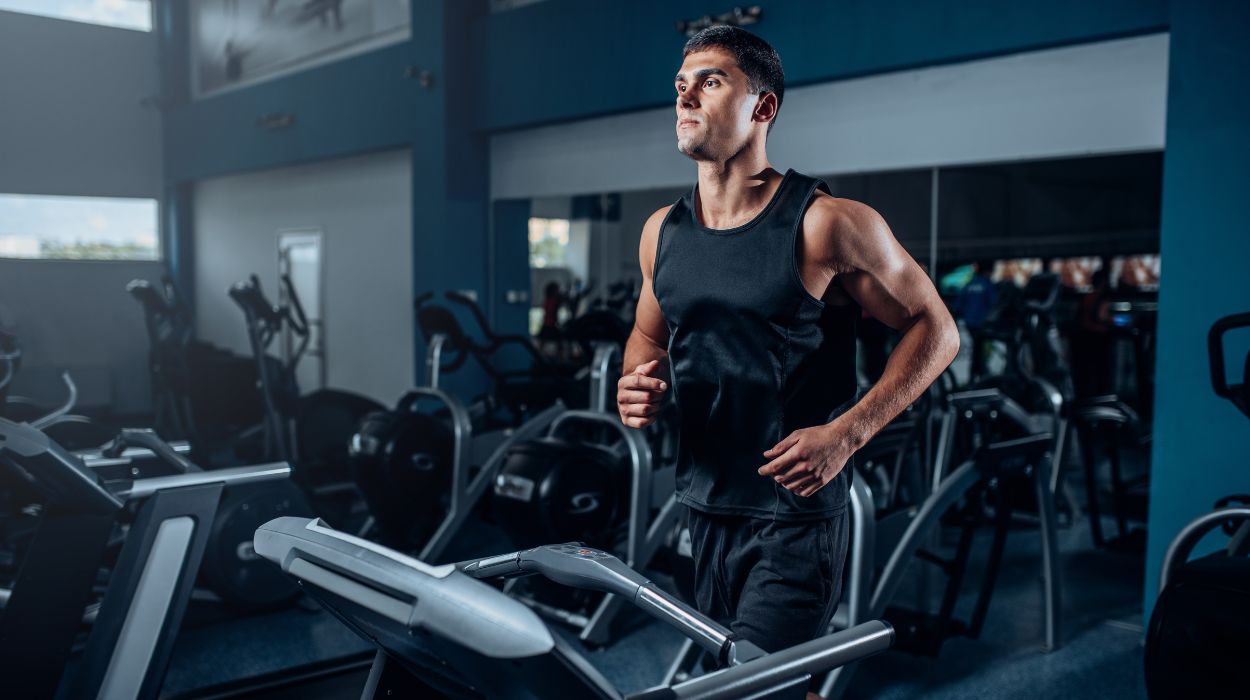
Can cardio help you lose weight? The short answer is: yes,[1] cardio will certainly help you if your goal is losing weight. Weight loss is a simple equation – all that you need to do to lose weight is expend more calories[2] than you take in daily.
Cardio exercise and other forms of full-body exercise like high-intensity interval training are all excellent ways to burn calories in your free time. The more calories burned, the more you will lose weight.
Best Cardio For Weight Loss
There are so many ways to get a great workout. If you’re new to cardio exercises at gym or have physical limitations that make intense bursts of activity difficult, you can try a form of cardio that gets your heart pumping without putting you on the floor.
Low-Intensity Cardio Workouts For Fat Loss
If the thought of doing sprints is enough to make you groan, you’ll be glad to hear that a low-intensity cardio workout is still a great way to kickstart your workout and increase your calorie deficit.
Treadmill
When most people think about an effective workout, the image of a treadmill is probably one that comes immediately to mind.
It’s true: treadmills are an extraordinarily convenient way to increase your overall fitness level and calorie expenditure, all from the comfort of your home or your favorite gym. Running on a treadmill isn’t just for leg day; it’s the ultimate full-body workout. How?
Your performance and the ability of the workout’s ability to reach every part of your body will both improve with time as your body adapts to a new routine. Start with a warm-up – walking briskly, perhaps with some music. Treadmills are awesome because you can tailor the routine to your current fitness levels.
Once your cardiovascular system is starting to feel the heat, you can increase your calorie expenditure by increasing the speed of the machine. As you improve and build up your leg muscles, your cardiovascular ability will increase proportionally. You’ll be burning fat like there’s no tomorrow.
Slowly ramping yourself up to levels of moderate physical activity will prevent you from injuring yourself. It will make the transition between entry-level cardio and much more vigorous exercise easy and manageable.
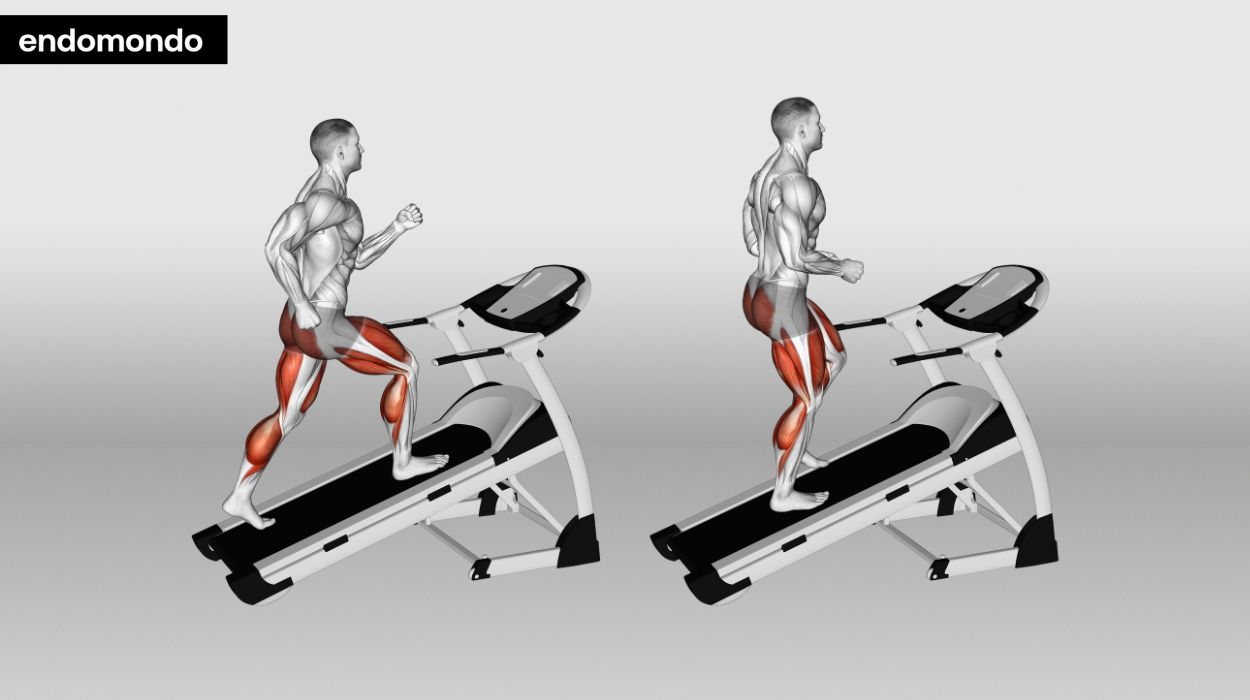
How to do:
- Start with a slow, comfortable walking pace.
- Gradually increase speed to a challenging yet sustainable level.
- Maintain an upright posture; lightly hold onto the handles if needed.
- Use consistent, natural strides; avoid overstriding.
- Cool down by gradually reducing speed before stopping.
Tips:
- Proper Footwear is Key: Wear supportive running shoes to reduce impact on joints.
- Vary Your Workouts: Incorporate intervals, inclines, and steady-state runs for balanced training.
- Stay Hydrated: Drink water before, during, and after to maintain hydration.
Optimal Sets and Reps: Start with a 5-10-minute warm-up, followed by 20-30 minutes of varied intensity, and conclude with a five-minute cool-down.
Stair Climber
A step-up cardio workout is one of the best types of exercise for fat loss; a stair climber challenges the whole body by working out the lower body with what is essentially an incline. You lift yourself with each step that you take, bearing your entire body weight.
Just like with a treadmill, this is another form of cardio for weight loss that can be customized completely to your needs. You can focus on building muscle strength by taking things slow and steep, or you can increase your calorie burn by cranking up the speed and going at it with everything that you’ve got.
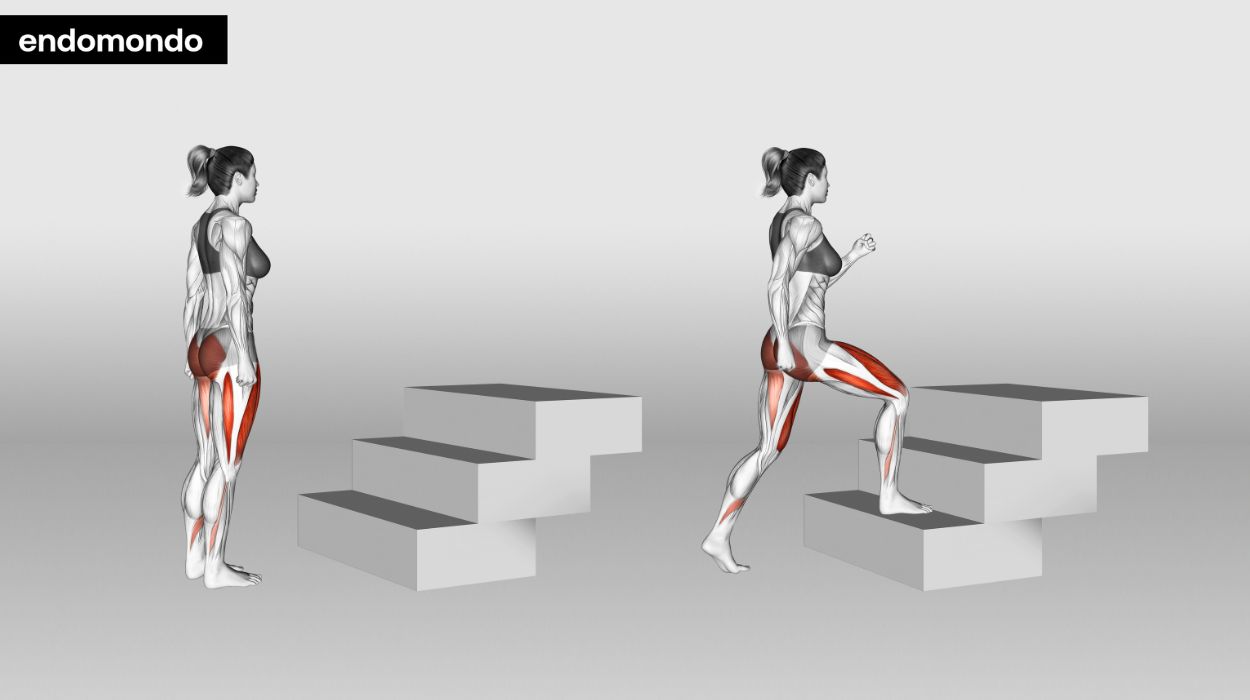
How to do:
- Start at a slow pace to find your rhythm.
- Stand upright, lightly gripping the handrails for balance.
- Step fully on each stair, engaging your core and glutes.
- Gradually increase speed or resistance for a challenge.
- Finish with a slow pace to cool down.
Tips:
- Maintain Proper Posture: Stand tall to maximize engagement and avoid strain.
- Use Your Legs, Not Arms: Drive with your legs to build strength and endurance.
- Vary Your Steps: Alternate between stepping patterns to engage different muscles.
Optimal Sets and Reps: Aim for 2-3 sessions, each lasting 15-20 minutes.
Elliptical Machines
Low-impact, easy on the knees, and just as potent as any of these other forms of cardiovascular exercise, elliptical machines are another great way to burn calories. Contrary to popular belief, you don’t exactly need to run yourself into the ground to burn body fat.
The elliptical machine might seem tame and sort of like a waste of your time at the gym, but this couldn’t be further from the truth. If the health benefits of using an elliptical machine suit you, but you find yourself bored to tears when you use one, try increasing the resistance to build more muscle mass in your legs as you progress. Again, you’ll get whatever you give when it comes to your exercise routine.
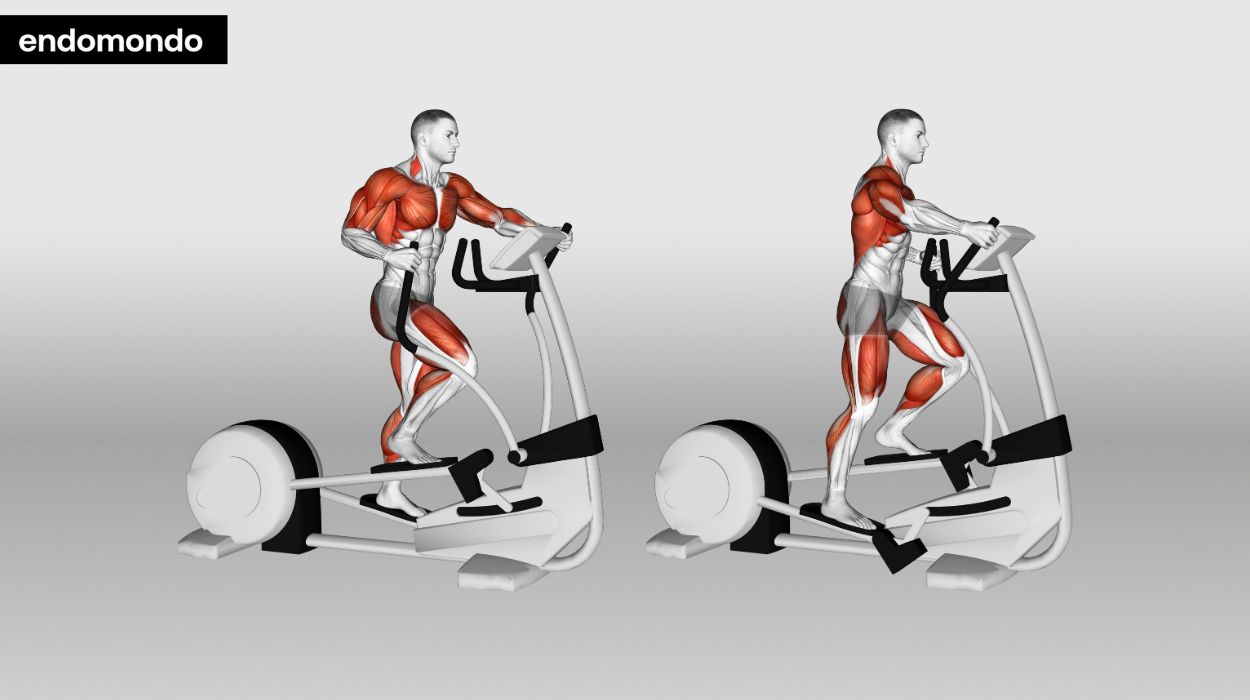
How to do:
- Adjust machine settings to fit your height and stride length.
- Start slowly to establish balance and rhythm.
- Use both arms and legs for a full-body workout.
- Gradually increase resistance or speed as needed.
- Cool down by reducing the pace towards the end.
Tips:
- Maintain Upright Posture: Keep your back straight and head up for efficiency.
- Engage Your Core: Tighten your abdominal muscles to enhance stability and workout intensity.
- Use Reverse Motion Occasionally: Switch to backward pedaling to target different muscle groups.
Optimal Sets and Reps: Aim for 1-2 sets of 20-30 minutes.
Other Cardio Machines Like An Exercise Bike Or Peloton
Sitting while we exercise? That sounds like our kind of thing.
Even though you do, take a seat while riding a stationary bike or Peloton, it’s just as good as an elliptical or any other form of low-impact cardio in terms of calories burned. The conductors of the experiment focused especially on the change in body composition and muscle tissue. The majority of the change occurred in each of the participants’ subcutaneous fat stores.
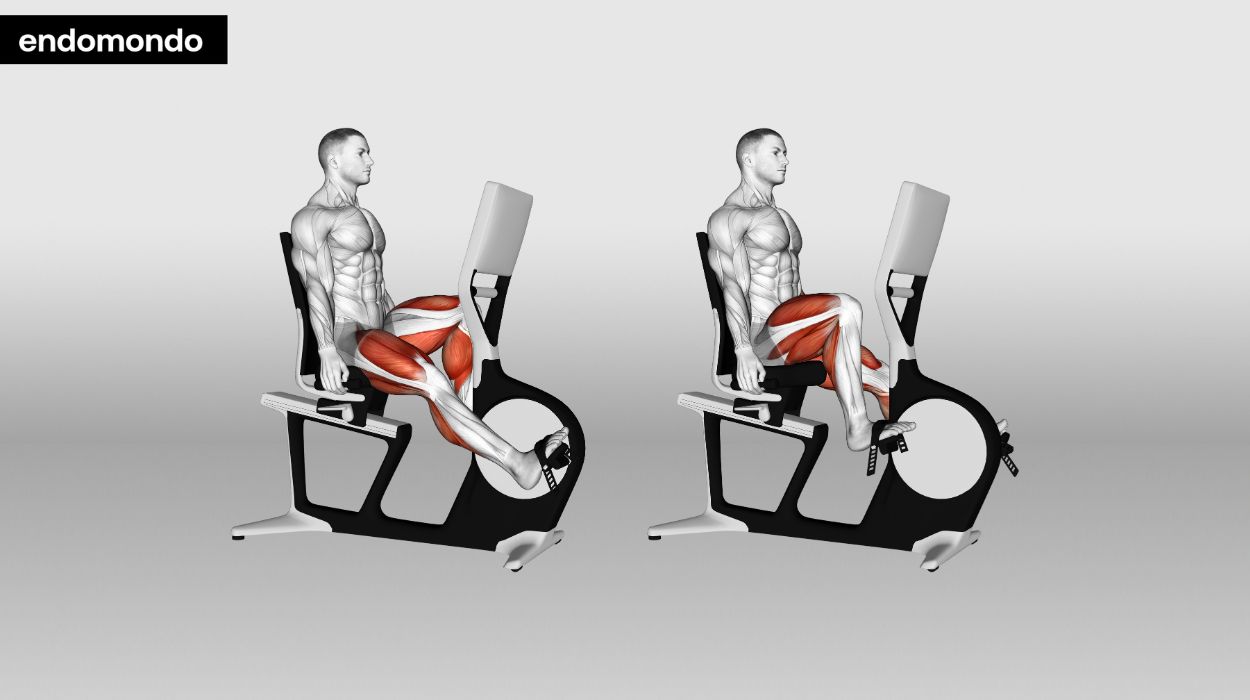
How to do Peloton:
- Adjust the seat and handlebars to match your height.
- Start with a low-resistance warm-up.
- Choose a class or program that fits your goal.
- Maintain a steady pace; focus on form.
- Cool down with low resistance; stretch post-ride.
Tips:
- Maintain proper posture: When using the Peloton bike, keep your back straight, and shoulders relaxed, and engage your core to support your spine.
- Adjust resistance mindfully: Don’t hesitate to modify the resistance on your Peloton bike to challenge yourself.
- Focus on your breathing: Practice controlled and rhythmic breathing while riding the Peloton to optimize your cardiovascular performance.
Optimal Sets and Reps: Each session can vary in duration from 20-60 minutes.
Swimming
There are few forms of exercise more relaxing than going for a swim. If you’re lucky enough to own a pool or have one close by, swimming laps work out your entire body, which means you’re losing weight everywhere, all at once.
Like with any type of cardio, the calories burned swimming will ultimately depend on the amount of effort you put into your workout. To burn more calories, you can add weighted equipment or challenge yourself to swim the next lap faster than the last one.

How to do:
- Lie face down in the water.
- Extend arms and legs.
- Alternate lifting arms and legs.
- Keep a steady, rhythmic motion.
- Engage core muscles for stability.
Tips:
- Focus on form: Keep your body in a streamlined position, kick from your hips, and maintain a rhythmic arm and leg movement.
- Breathe rhythmically: Coordinate your breathing with your strokes. Inhale when your face is in the water, and exhale when you turn your head to breathe.
- Vary intensity: Mix up your swimming pace to challenge your cardiovascular fitness.
Optimal Sets and Reps: 20-45 minutes of continuous swimming.
Walking Or Jogging Outside
Some academic research institutions contend that even gentle cardiovascular workouts will significantly increase[3] the amount of weight loss that you will see.
Cardiovascular workouts come in all shapes and sizes. If a daily jaunt through your neighborhood gets you up and out the door, all the better. You’ll lose weight slowly and steadily if your caloric intake does not exceed what you’re able to achieve.
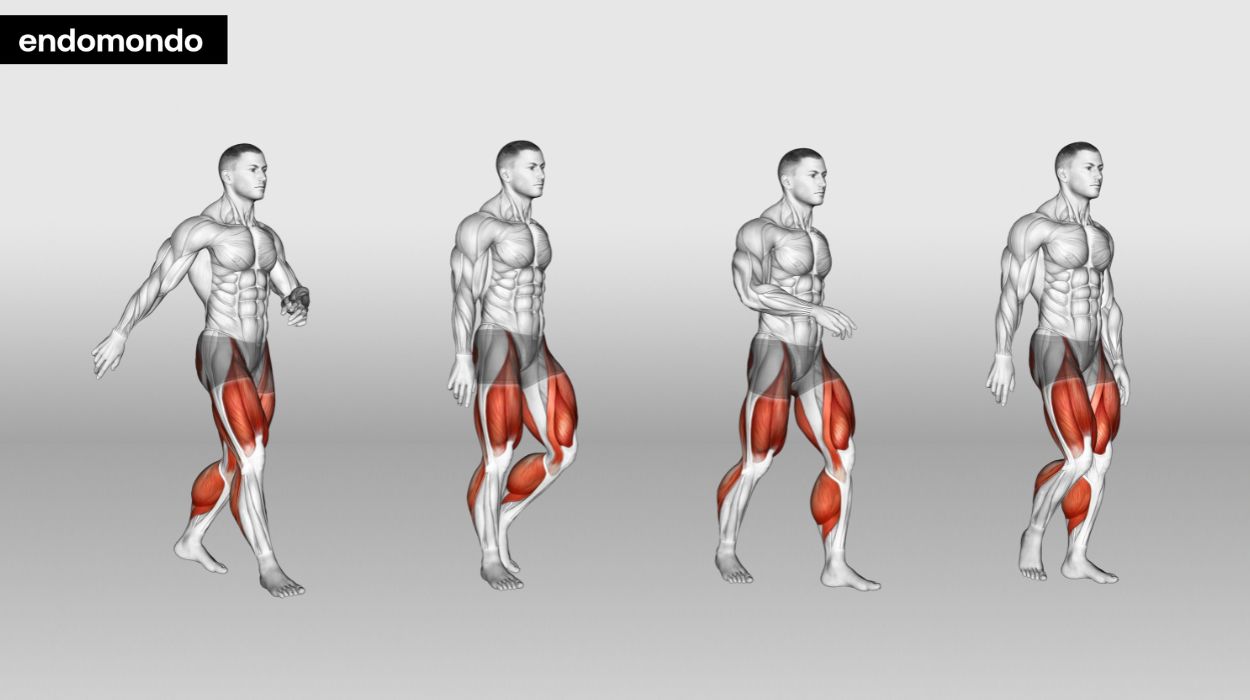
How to do Jogging:
- Start with a brisk walk.
- Gradually increase speed to a comfortable jogging pace.
- Maintain a steady rhythm.
- Swing arms naturally.
- Breathe deeply and rhythmically.
Tips:
- Proper footwear is essential: Wear comfortable, supportive running shoes to reduce the risk of injury and enhance performance.
Optimal Sets and Reps: Progress to 30-45 minutes of jogging, 4-5 times per week.
High-Intensity Interval Training (HIIT) For Weight Loss

While low-intensity aerobic cardio is generally regarded as the best type of total-body workout for fat loss for the average person, incorporating high-intensity exercise into your routine is a much more aggressive way to burn fat.
These routines won’t have you working overtime for the whole session – HIIT workouts call for rest periods between bursts of intense physical activity, giving you time to regain your composure periodically throughout the entire workout.
If you can master HIIT, you’ll find that it’s some of the cardio exercises for weight loss when training yourself to the extreme.
Upper Body HIIT Workouts
If you would like to add an element of strength training to your weight loss plan, there are so many ways to burn more calories by really throwing your arms and shoulders into your workout.
There are two ways to do many of the HIIT exercises you see online – the bodyweight version and the weight training version, which usually involve dumbbells, wrist and ankle weights, medicine balls, or any other accessory meant to burn fat more effectively.
One of our favorites, the Up and Down Plank, is an incredible overall body exercise, increasing your stamina, shoulder strength, and abdominal strength, all at once.
Hunker down into a plank position, and, one arm at a time, get down on your elbows. Resume your first position, again, pushing yourself up one arm at a time. Repeat this process until you have reached the point of exhaustion. Take a rest, and begin another set.
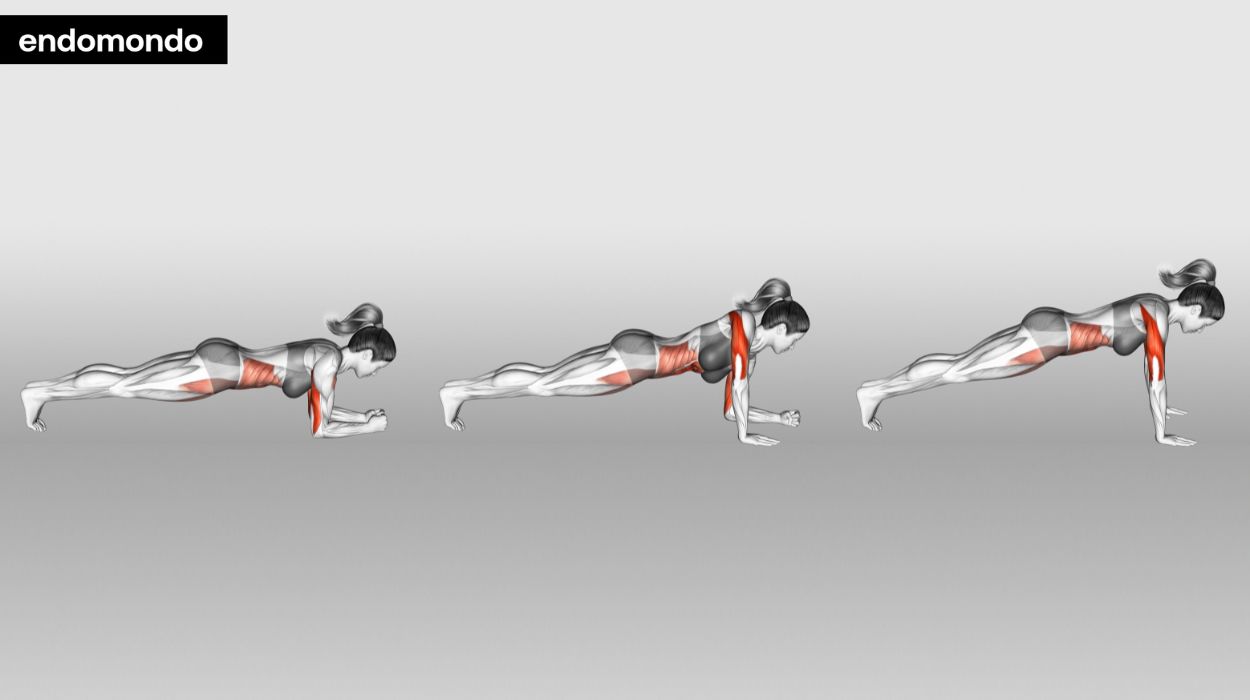
How to do Up and Down Plank:
- Begin in a plank position on your forearms.
- Push up onto your hands, one arm at a time.
- Return to forearm plank, one arm at a time.
- Keep your core engaged and maintain a straight line.
- Repeat for desired reps or time.
Tips:
- Keep your wrists aligned with your shoulders to prevent strain.
- Engage your core throughout to maintain stability and prevent sagging.
- Start with shorter durations and gradually increase intensity to avoid overexertion.
Optimal Sets and Reps: 3-4 sets of 10-12 reps (per arm transition).
Lower Body HIIT Workouts
If your booty could use a lift, you’re in luck. Several peer-reviewed studies have shown just how effective HIIT is when targeting specific areas of the body,[4] such as the thighs or belly.
It’s no surprise – these moves put even us through the wringer. Some lower-body HIIT simulates the action that a treadmill facilitates – moves like High Knees and Skater Hops get you moving, essentially jogging in place. Lunges and Reverse Lunges are also excellent for beginners who need to get themselves up to speed. Taking things slowly and deeply will have you sweating in no time.
If you’re interested in strength training that focuses on the core, Flutter Kicks will help you lose fat hanging around the midsection, targeting trouble areas that might be difficult to reach otherwise.
Simply lie on your back, lift your legs off of the ground by about a foot, and pull one up high without letting the other one hit the ground again. Lower the one in the air and replace it with the opposite leg. Continue to alternate, fluttering until you’re ready for a breather.
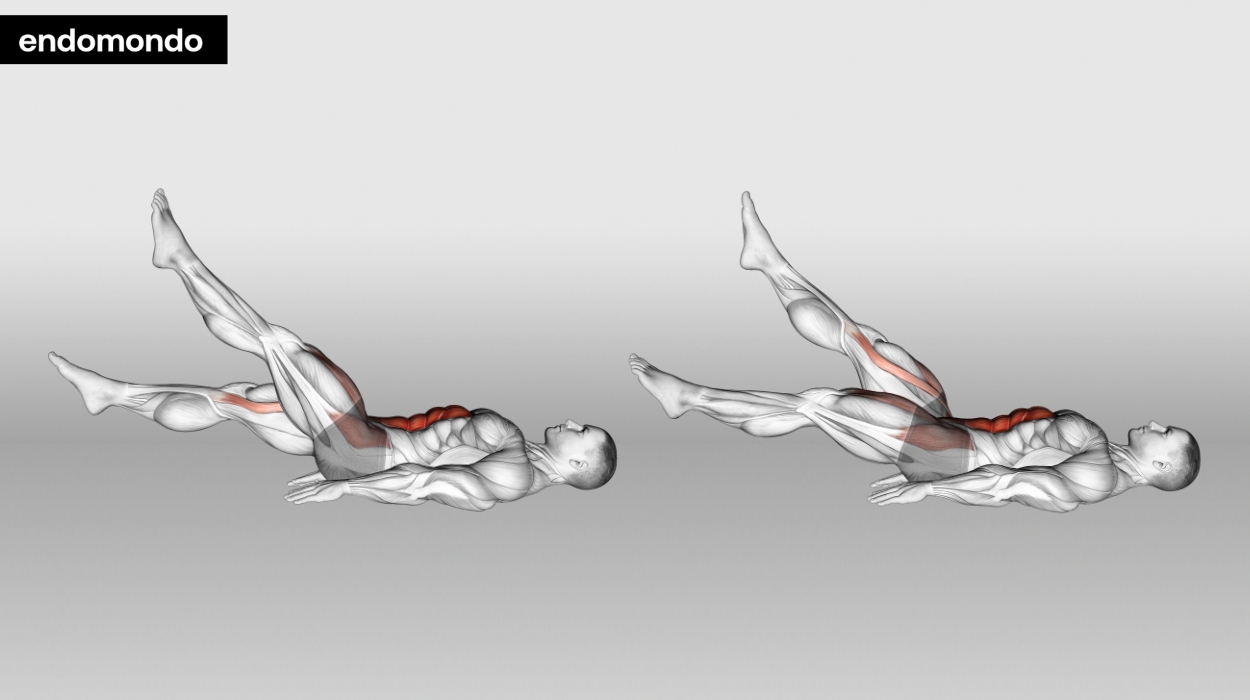
How to do Flutter Kicks:
- Lie flat on your back.
- Keep your legs straight.
- Alternate kicking legs up and down.
- Engage core muscles.
- Maintain steady, controlled movements.
Tips:
- Support your lower back by placing your hands under your hips.
- Keep your legs straight but avoid locking your knees to prevent strain.
- Start with a small range of motion and gradually increase it to maintain control and avoid straining your lower back.
Optimal Sets and Reps: Progress to 3-4 sets of 30-45 seconds.
Jump Rope
Jumping rope isn’t just for kids; it’s one of the most effective forms of aerobic exercise out there, especially if you include a weighted jump rope in your exercise regime. Jumping rope improves flexibility[5] and helps you build stamina throughout your entire core.
Even if you run primarily as your cardio exercise of choice, improving the strength of your core is one of the biggest favors that you can do for yourself in the long run. Jump roping feels silly at first, but you’ll feel it working the day that you start.

How to do:
- Hold rope handles at hip height.
- Swing the rope over your head.
- Jump with both feet as the rope passes underneath.
- Land softly on the balls of your feet.
- Maintain a consistent rhythm.
Tips:
- Proper form matters: Keep elbows closed, and wrists relaxed, and jump lightly on the balls of your feet.
- Consistency is key: Practice regularly to improve coordination and endurance.
- Gradually increase intensity: Start with shorter sessions and progress to longer durations as your fitness improves.
Optimal Sets and Reps: Progress to 4-5 sets of 2-3 minutes of jumping.
Jumping Jacks
Most people haven’t done jumping jacks since middle school, but it’s a quick and easy workout that you can always keep in your back pocket when trying to lose weight.
Stand up straight, and hop your feet out so that your legs are slightly spread; at the same time, draw your arms up over your head, bending them in toward each other slightly. Hop again, this time returning to your original position. Continue in this way rapidly until you’ve had enough.
An alternate version of this exercise, Jump Squats, invites your butt to the party. You’ll enjoy all of the benefits of a bonafide Sumo Squat as you jump continuously. Burning calories has never been more efficient.
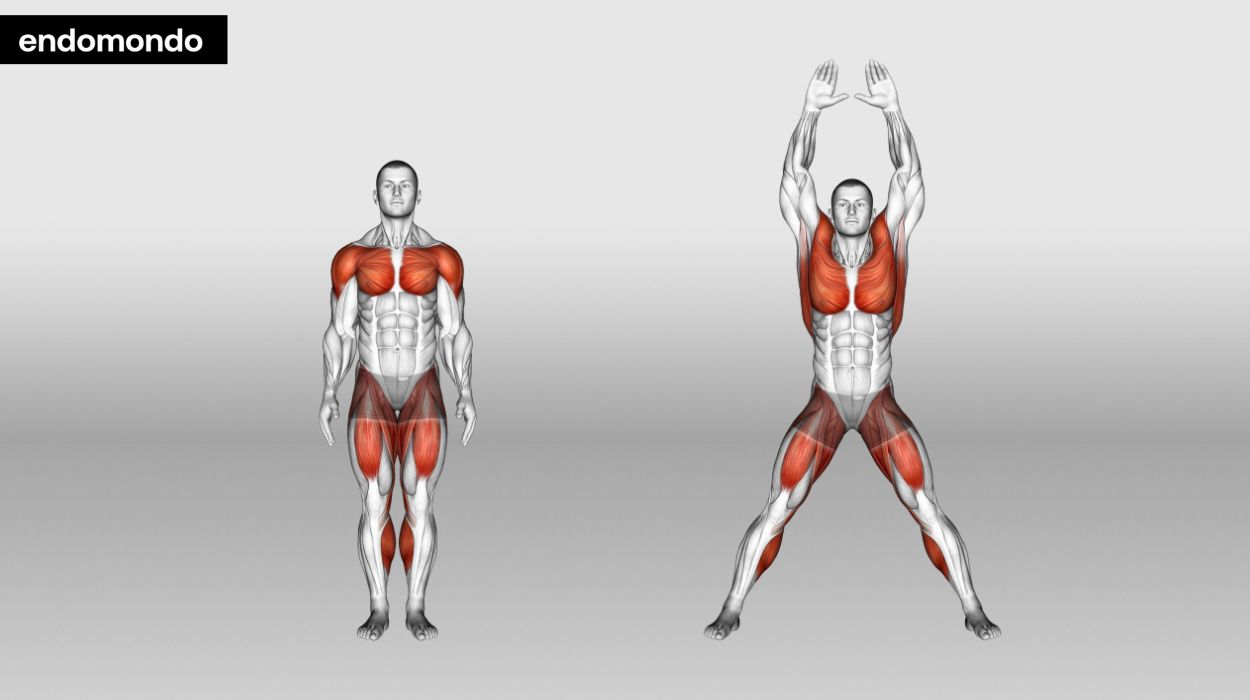
How to do:
- Stand with feet together, arms at sides.
- Jump, spreading legs, and raising arms overhead.
- Return to the starting position with arms and legs together.
- Maintain a steady, controlled rhythm.
- Breathe naturally throughout the exercise.
Tips:
- Land softly: Protect your joints by landing with slightly bent knees.
- Engage your core: Maintain stability and prevent arching your back.
- Modify for impact: If needed, perform low-impact versions to reduce stress on joints.
Optimal Sets and Reps: Progress to 4 sets of 20-30 Jumping Jacks.
Rowing Machine
Some consider rowing[6] to be the ultimate form of weight training. Rowing helps you burn calories like crazy because it gets the entire body involved – the abs, the arms, the upper back, the chest, and even your obliques.
Rowing is the perfect choice for you if you struggle with joint issues but still want an intense workout; several medically reviewed trial studies have shown that rowing might even help relieve some of these conditions.[7]
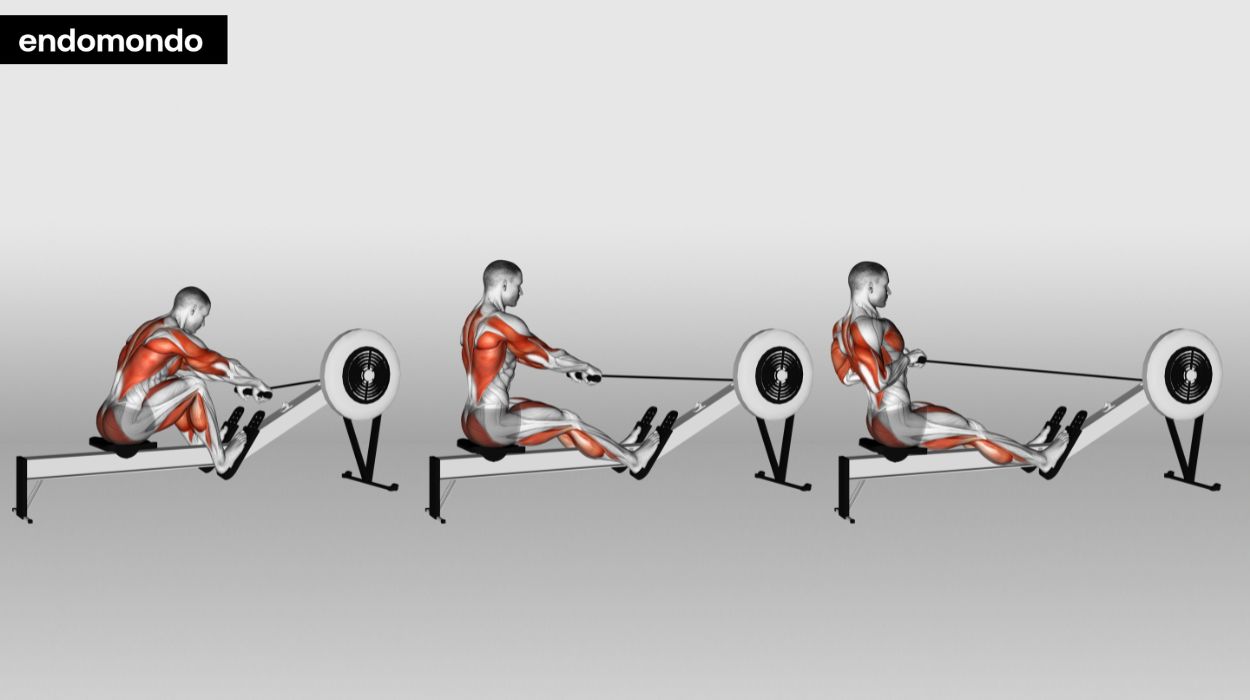
How to do:
- Sit, strap in, and adjust footrests.
- Grasp the handle with an overhand grip.
- Push the legs, then pull the handle toward the chest.
- Extend arms, then bend knees, returning to start.
- Maintain smooth, fluid motion and proper posture.
Tips:
- Focus on proper technique: Master the correct rowing form to prevent injury and maximize efficiency.
- Control your pace: Start with moderate resistance and increase it gradually to avoid overexertion.
- Engage your core: Maintain a strong core throughout the rowing motion for stability.
Optimal Sets and Reps: Progress to 4 sets of 10-15 minutes.
Burpees
Anybody who’s ever done a burpee knows how effective they are when trying to lose weight. This all-inclusive move, if done correctly, improves the fitness of pretty much all of your major muscle groups – the legs, the abdominal muscles, and even the shoulders.
This one is a doozy, but the calories burned will be worth it. We invite you to give all of these cardio workouts a try during your next trip to the gym, or even just at home.
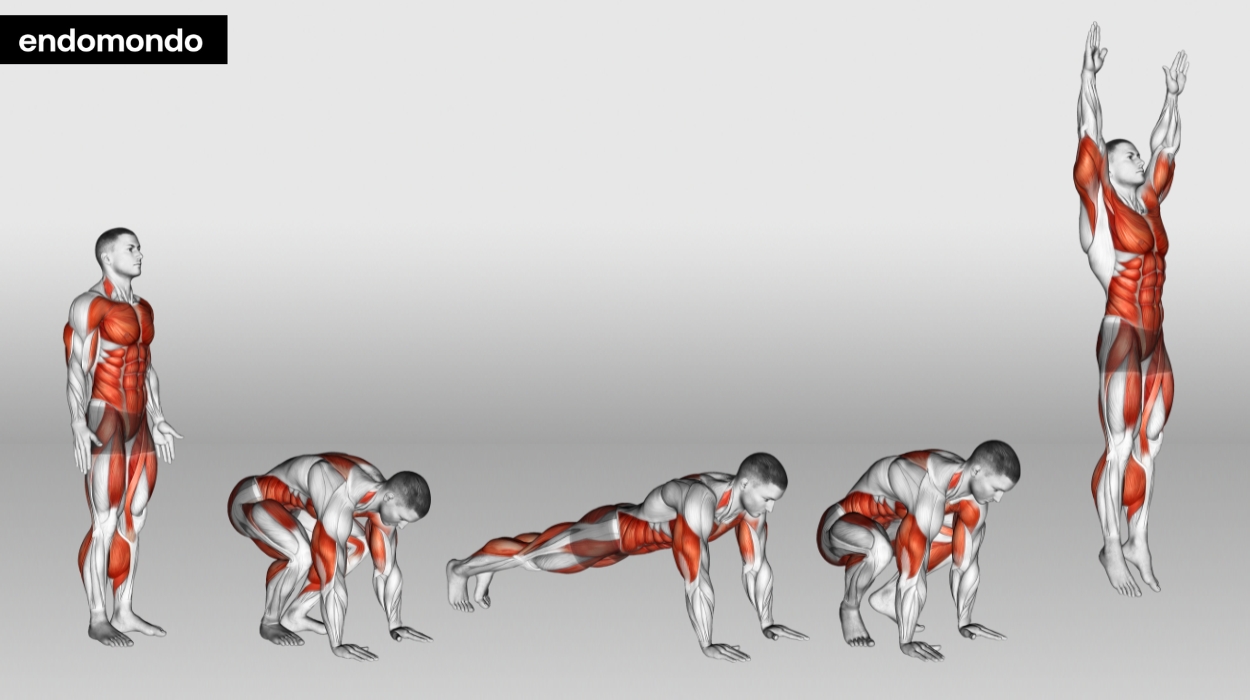
How to do:
- Stand up straight with your arms at your side.
- Squat and press your hands down in front of you.
- Hop your legs back into a plank position.
- Perform a push-up.
- Rise back up and bring your knees into your chest in another squat.
- Jump up and point both arms straight up into the air.
Tips:
- Maintain proper form: Keep a flat back during the push-up and land softly to protect your joints.
- Breathe rhythmically: Coordinate your breathing with each phase of the exercise.
- Modify if needed: Start with a modified version, like stepping back instead of jumping, and gradually progress.
Optimal Sets and Reps: Progress to 3-4 sets of 10-12 reps.
Cardio Exercise Benefits
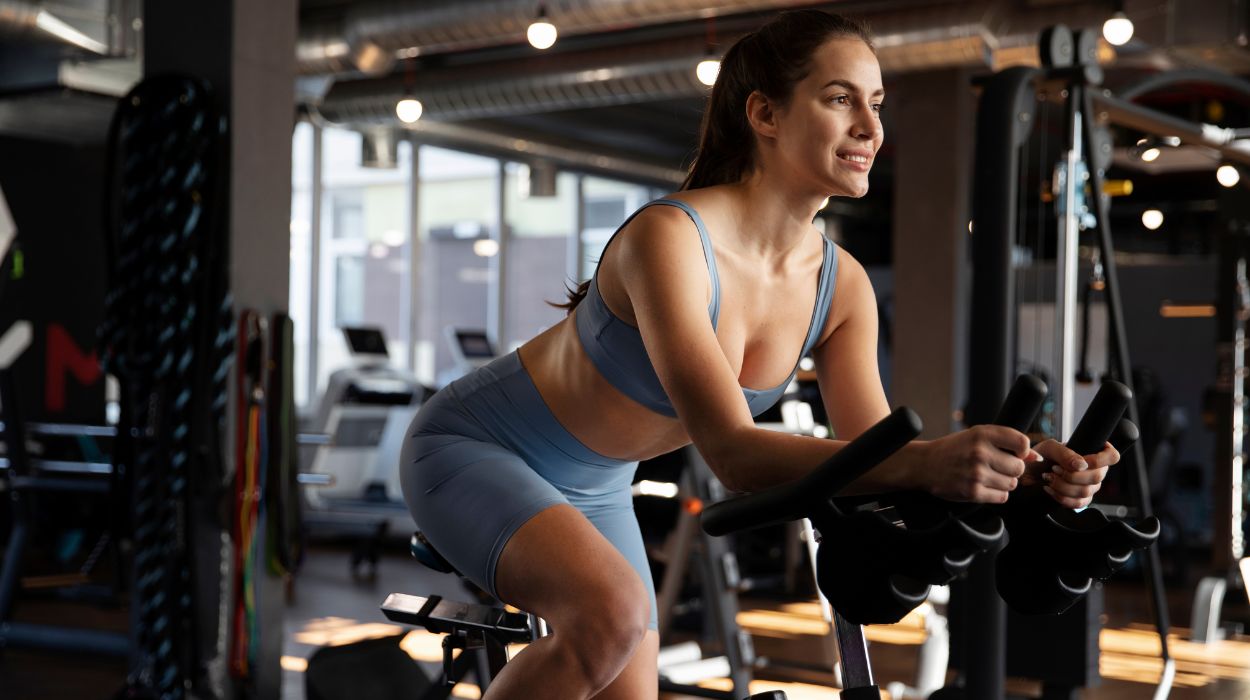
The benefits of a regular cardio routine are undeniable.[8] The more our bodies move, the less likely they are to develop and hold unwanted body fat.
While maintaining a wide calorie deficit, nourishing your body adequately, and adhering to strict sourcing guidelines when it comes to your intake is certainly one side of the coin to consider, these efforts will largely be in vain if the rest of your lifestyle is not in alignment with your goals, as well.
Very few people can live well long-term without some form of exercise in their lives. Why is exercise so important when it comes to maintaining a healthy weight?
Cardio Workouts And Metabolism
One’s resting metabolic rate, also known as resting energy expenditure, is the number of calories that the body burns ordinarily over an average day. Increasing your RMR is the key to a sustainable, long-term weight loss journey. One of the best ways to accomplish this is via full-body exercise,[9] but not necessarily through a strength training regime.
Aerobic cardio workouts have been shown to increase the metabolic rates[10] of participants, more so than weight training on its own.
Other Health Benefits Of Cardio Workouts
One medically-reviewed study found that physical activity correlated positively[11] with a decrease in the likelihood of each subject falling victim to heart disease later in life. We’re not ones to try to provide unsolicited medical advice, but this simple fact does sweeten the deal.
Resources
- Donnelly, J.E., Honas, J.J., Bryan Ronain Smith, Mayo, M.S., Gibson, C.A., Sullivan, D.K., Lee, J.-H., Herrmann, S.D., Lambourne, K. and Washburn, R.A. (2013). Aerobic exercise alone results in clinically significant weight loss for men and women: Midwest exercise trial 2. [online] 21(3), pp.E219–E228. doi:https://doi.org/10.1002/oby.20145.
- Strasser, B., Spreitzer, A. and Haber, P.S. (2007). Fat Loss Depends on Energy Deficit Only, Independently of the Method for Weight Loss. [online] 51(5), pp.428–432. doi:https://doi.org/10.1159/000111162.
- Manson, J.E., Greenland, P., LaCroix, A.Z., Stefanick, M.L., Mouton, C.P., Oberman, A., Perri, M.G., Sheps, D.S., Pettinger, M. and Siscovick, D.S. (2002). Walking Compared with Vigorous Exercise for the Prevention of Cardiovascular Events in Women. [online] 347(10), pp.716–725. doi:https://doi.org/10.1056/nejmoa021067.
- Spiros Tsirigkakis, Mastorakos, G., Yiannis Koutedakis, Vassilis Mougios, Nevill, A.M., Pafili, Z. and Bogdanis, G.C. (2021). Effects of Two Workload-Matched High-Intensity Interval Training Protocols on Regional Body Composition and Fat Oxidation in Obese Men. [online] 13(4), pp.1096–1096. doi:https://doi.org/10.3390/nu13041096.
- Yang, X., Lee, J.-Y., Gu, X., Zhang, X.-X. and Zhang, T. (2020). Physical Fitness Promotion among Adolescents: Effects of a Jump Rope-Based Physical Activity Afterschool Program. [online] 7(8), pp.95–95. doi:https://doi.org/10.3390/children7080095.
- Ingham, S.A., Carter, H., Whyte, G.P. and Doust, J.H. (2008). Physiological and Performance Effects of Low- versus Mixed-Intensity Rowing Training. [online] 40(3), pp.579–584. doi:https://doi.org/10.1249/mss.0b013e31815ecc6a.
- Kang, S.-R., Chang Sik Yu, Han, K.-S. and Kwon, T.-K. (2014). Comparative analysis of basal physical fitness and muscle function in relation to muscle balance pattern using rowing machines. [online] doi:https://doi.org/10.3233/bme-141056.
- CDC (2023). Benefits of Physical Activity . [online] Centers for Disease Control and Prevention. Available at: https://www.cdc.gov/physicalactivity/basics/pa-health/index.htm.
- Research Quarterly. American Association for Health, Physical Education and Recreation. (2013). Aftereffects of Exercise upon Resting Metabolic Rate. [online] Available at: https://www.tandfonline.com/doi/abs/10.1080/10671188.1963.10613239.
- Ballor, D.L. and Poehlman, E.T. (1992). Resting metabolic rate and coronary-heart-disease risk factors in aerobically and resistance-trained women. [online] 56(6), pp.968–974. doi:https://doi.org/10.1093/ajcn/56.6.968.
- Mihaela Tanasescu (2002). Exercise Type and Intensity in Relation to Coronary Heart Disease in Men. [online] 288(16), pp.1994–1994. doi:https://doi.org/10.1001/jama.288.16.1994.




